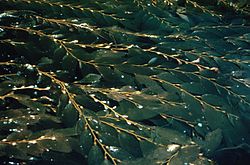Canopy (biology)
A canopy or forest canopy is part of a tree, forest, group of trees, or group of other tall plants. It is where the leaves spread out like a roof or umbrella.[1]
The canopy is where the most sunlight touches the plants, so it is where the most energy enters living things.[2] It is also where the most gas exchange happens, where oxygen and carbon dioxide and water vapor go in and out of the leaves.[3] Many animals live in the canopy.
Canopy (biology) Media
The canopy of a forest in Sabah, Malaysia
Macrocystis pyrifera – giant kelp – forming the canopy of a kelp forest
Bamboo canopy in the Western Ghats of India
A monkey-ladder vine canopy over a road
References
- ↑ "Forest Canopy". Science Direct. Retrieved December 27, 2021.
- ↑ R. Seidler (2017). "Patterns of Biodiversity Change in Anthropogenically Altered Forests☆". Patterns of Biodiversity Change in Anthropogenically Altered Forests. Reference Module in Life Sciences. doi:10.1016/B978-0-12-809633-8.02186-5. ISBN 9780128096338.
- ↑ Nalini M. Nadkarni; Geoffrey G.Parker; H. Bruce Rinker; David M. Jarzen (2004). "CHAPTER 1 - The Nature of Forest Canopies". Forest Canopies. Physiological Ecology (2 ed.). pp. 3–23. doi:10.1016/B978-012457553-0/50005-8. ISBN 9780124575530. Retrieved December 27, 2021.





